ML Aggarwal Class 6 Solutions Chapter 15 provides comprehensive guidance and step-by-step explanations for the concepts covered in this chapter Class 6 Mathematics. This chapter typically introduces fundamental mathematical concepts, laying the groundwork for future studies.
ML Aggarwal Class 6 Chapter 15 Solutions
ICSE Class 6 Maths Chapter 15 Solutions ML Aggarwal
Mental Maths
Question 1.
Fill in the blanks:
(i) A ……. is a collection of numerical figures to give some information.
(ii) Each numerical figure in a data is called an ………..
(iii) The number of times a particular observation occurs in a data is called … of the observation.
(iv) A data arranged in ascending or descending order is called an ………… data.
(v) A pictorial representation of a data is called a …………
(vi) If ![]() represent 5 students then
represent 5 students then ![]() represent ………… students.
represent ………… students.
(vii) In a pictograph, if one bicycle represents 20 bicycles then 140 bicycles can be represented by ………… bicycles.
(viii)In a pictograph, if one electric bulb represents 10 bulbs then the picture of half a bulb will represent ………… bulbs.
(ix) In a pictograph, if the symbol ![]() represents 50 fruits baskets, then
represents 50 fruits baskets, then ![]()
![]() represent ………… fruit baskets.
represent ………… fruit baskets.
(x) The frequency of 8 is written symbolically as ………… using tally marks.
(xi) In a bar graph, the bars are of uniform …………
(xii) The mean of the first 8 natural numbers is …………
Solution:
(i) A data is a collection of numerical figures to give some information.
(ii) Each numerical figure in a data is called an observation.
(iii) The number of times a particular observation
occurs in a data is called frequency of the observation.
(iv) A data arranged in ascending or descending order
is called an arrayed data.
(v) A pictorial representation of a data is called a pictograph.
(vi) If ![]() represent 5 students then
represent 5 students then ![]() represent 15 students.
represent 15 students.
(vii) In a pictograph, if one bicycle represents 20 bicycles
then 140 bicycles can be represented by 7 bicycles.
(viii)In a pictograph, if one electric bulb represents 10 bulbs
then the picture of half a bulb will represent 5 bulbs.
(ix) In a pictograph, if the symbol ![]() represents 50 fruits baskets,
represents 50 fruits baskets,
then ![]()
![]() represent 120 fruit baskets.
represent 120 fruit baskets.
(x) The frequency of 8 is written symbolically
as ![]() using tally marks.
using tally marks.
(xi) In a bar graph, the bars are of uniform width.
(xii) The mean of the first 8 natural numbers is 4.5
Question 2.
State whether the following statements are true (T) or false (F):
(i) If the data is large, it is difficult to get information from raw data.
(ii) Pictographs and bar graphs help us in understanding and analyzing a data.
(iii) In a bar graph, bars can be drawn either vertically or horizontally.
(iv) In a bar graph, width of a bar has no significance. It is only for eye attraction.
(v) Usually, the tally marks are recorded in bunches of 5.
(vi) The frequency 9 is represented as filtlll using tally marks.
(vii) Mentioning of scale is necessary in pictographs.
(viii) Mean is always one of the number in a given data.
(ix) Median is always one of the numbers in a given data.
Solution:
(i) If the data is large, it is difficult to get information
from raw data. True
(ii) Pictographs and bar graphs help us in understanding
and analyzing a data. True
(iii) In a bar graph, bars can be drawn either vertically
or horizontally. True.
(iv) In a bar graph, width of a bar has no significance.
It is only for eye attraction. True
(v) Usually, the tally marks are recorded in bunches of 5. True
(vi) The frequency 9 is represented as fMI using tally marks. False
(vii) Mentioning of scale is necessary in pictographs. True
(viii) Mean is always one of the number in a given data. False
(ix) Median is always one of the numbers in a given data. False
Multiple Choice Questions
Observe the following pictograph which shows the number of ice cream cones sold by school ‘ canteen during a week. Chose the correct answer from the given options for questions 3 to 7:
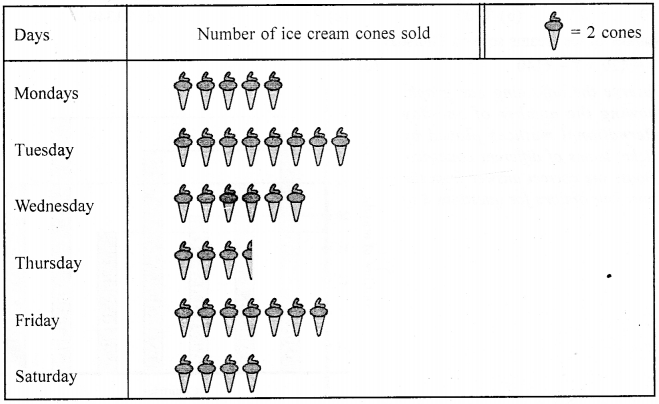
Question 3.
The minimum number of ice cream cones were sold on:
(a) Monday
(b) Saturday
(c) Tuesday
(d) Thursday
Solution:
Thursday (d)
Question 4.
The maximum number of ice cream cones were sold on:
(a) Tuesday
(b) Friday
(c) Wednesday
(d) Thursday
Solution:
Tuesday (a)
Question 5.
Ratio of the number of ice cream cones sold on Saturday to the number of ice cream cones sold on Wednesday is.
(a) 3 : 2
(b) 2 : 3
(c) 4 : 5
(d) 4 : 7
Solution:
Saturday = 8
Wednesday = 12
⇒ 8 : 12
⇒ 2 : 3 (b)
Question 6.
Total number of ice cream cones sold during the whole week was:
(a) 33
(b) 67
(c) 65
(d) 57
Solution:
Monday = 10
Tuesday = 16
Wednesday = 12
Thursday = 7
Friday = 14
Saturday = 8
Total 67 ice cream (b)
Question 7.
If the cost of one ice cream cone is ₹20, then the sale value on Thursday was:
(a) ₹70
(b) ₹100
(c) ₹140
(d) ₹1340
Solution:
Number of ice creams sold on Thursday = 7
= ₹20 × 7 = ₹140 (c)
Observe the adjoining bar graph, showing the number of one-day international mathces played by cricket teams of different countries. Choose the correct answer from the given four options for questions 8 to 11:
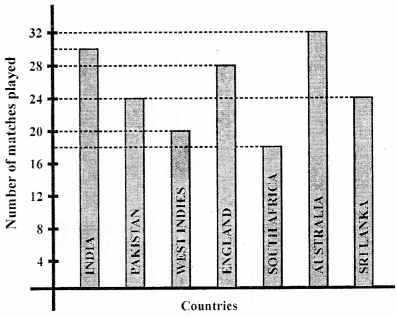
Question 8.
Which country played maximum number of matches? .
(a) India
(b) England
(c) Pakistan
(d) Australia
Solution:
Australia (d)
Question 9.
How many matches did South Africa play?
(a) 16
(b) 18
(c) 20
(d) 24
Solution:
18 (b)
Question 10.
How many more matches were played by India than Pakistan?
(a) 6
(b) 12
(c) 24
(d) 30
Solution:
Pakistan = 24
India = 30
∴ 30 – 24 = 6 (a)
Question 11.
Ratio of the number of matches played by India to the number of matches played by Sri Lanka is
(a) 4 : 5
(b) 5 : 4
(c) 4 : 3
(d) 7 : 6
Solution:
India = 30
Sri Lanka = 24
⇒ 30 : 24 = 5 : 4 (b)
Choose the correct answer from the given four options for questions 12 and 13:
Question 12.
The mean of the first 6 odd natural numbers is
(a) 5
(b) 5.5
(c) 6
(d) 6.5
Solution:
First 6 odd natural numbers are:
1, 3, 5, 7, 9, 11
1 + 3 + 5 + 7 + 9 + 11
Mean = \(\frac{1+3+5+7+9+11}{6}\)
= \(\frac{36}{6}=6\) (c)
Question 13.
The median of the numbers 4, 4, 7, 5, 7, 6, 1, 3, 11 is
(a) 7
(b) 6
(c) 5
(d) 4
Solution:
Arrange the data in ascending order : 3, 4, 4, 5, 6, 7, 1,1, 11
Total terms = 9
Median = \(\left(\frac{n+1}{2}\right)\)th term
= \(\frac{9+1}{2}\) = 4th term = 6 (b)
ML Aggarwal Class 6 Solutions for ICSE Maths Chapter 15 Data Handling Check Your Progress
Question 1.
A die is thrown 25 times and the scores were as given below :
2, 1, 4, 6, 2, 3, 1, 5, 6, 3, 4, 5, 2, 1, 6, 6, 6, 3, 2, 2, 2, 4, 3, 2, 2
(i) Construct data array.
(ii) Construct tally chart and frequency distribution table.
Solution:
(i) Data Array is constructed by writing the scores in the ascending order.
1, 1, 1, 2, 2, 2, 2, 2, 2, 2, 2, 3, 3, 3, 3, 4, 4, 4, 5, 5, 6, 6, 6, 6, 6
(ii) Tally chart and frequency distribution table

Question 2.
In primary school, the number of students in different classes are as follows:

Represent this data by a pictograph, using ![]() ≃ 20 students.
≃ 20 students.
Solution:
The pictograph for the given information is:
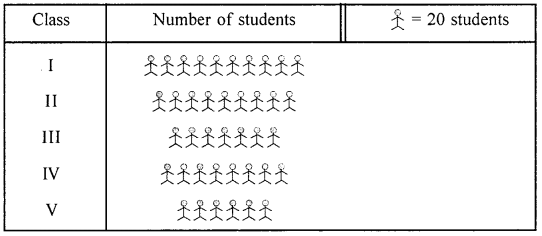
Question 3.
Observe the following bar graph, showing the marks scored by Gurmeet in the annual examination in different subjects:Answer the following questions:
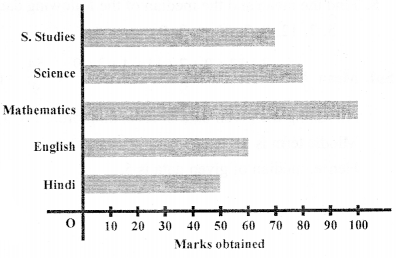
(i) What is the scale of this bar graph?
(ii) In which subject Gurmeet obtained maximum marks?
(iii) In which subject she obtained minimum marks?
(iv) Name the subject(s) in which she got 80 or more marks.
Solution:
(i) Scale: 1 unit length = 10 marks obtained u io
(ii) Mathematics
(iii) Hindi
(iv) Science and Mathematics
Question 4.
The following table shows the monthly expenditure of a family on various items:

Represent the data by a bar graph.
Solution:

Question 5.
Find the mean and the median of the following data:
5, 3, 12, 0, 7, 11, 4, 3, 9
Solution:
Mean = \(\frac{5+3+12+0+7+11+4+3+9}{9}=\frac{54}{9}\)= 6
Arranging the given data in ascending order: 0, 3, 3, 4, 5, 7, 9, 11, 12
Middle term is 5
Hence, median of given data is 5.
ML Aggarwal Class 6 Solutions for ICSE Maths Chapter 15 Data Handling Ex 15.1
Question 1.
Following is the choice of 20 students of class VI of a school:
Banana, Apple, Guava, Orange, Apple, Banana, Orange, Guava, Banana, Banana, Apple, Banana, Apple, Banana, Orange, Guava, Apple, Banana, Guava, Banana.
(i) Arrange the name of fruits in a table using tally marks.
(ii) Which fruit is liked by maximum number of students?
(iii) Which fruit is liked by minimum number of students?
Solution:
(i)
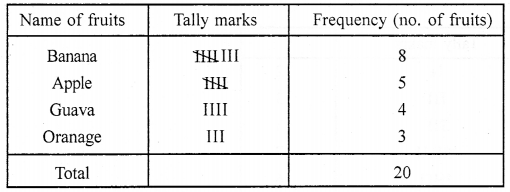
(ii) Banana
(iii) Orange
Question 2.
In a ready-made garment shop, on a particular day the following sizes of shirts were sold:
34, 38, 42, 40, 44, 32, 34, 36, 42, 40, 44, 36, 38, 42, 44, 40, 38, 40, 42, 32, 34, 38, 42, 40, 36, 42, 40, 38, 36, 40.
Arrange the above data in ascending order and construct frequency distribution table. Also answer the following questions:
(i) Which shirt size had the maximum sale?
(ii) Which shirt size had the minimum sale?
(iii) The number of shirts sold of size 42 or greater than size 42.
Solution:
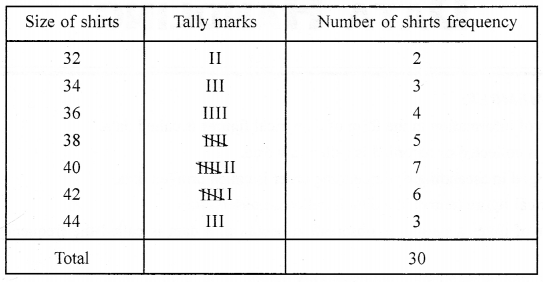
(i) 40
(ii) 32
(iii) 9
Question 3.
In a Mathematics test, the following marks were obtained by 40 students. Arrange these marks in a table using tally marks.

(i) Construct frequency distributioin table for the above data.
(ii) Find how many students obtained 7 marks or more than 7 marks.
(iii) How many students obtained marks below 4?
Solution:
(i)
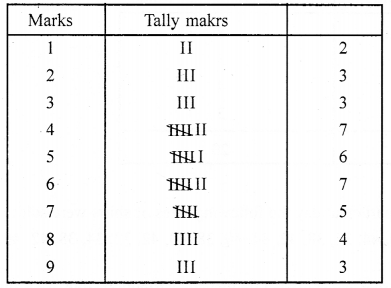
(ii) 5 + 4 + 3 = 12 students obtained marks equal to or more than 7.
(iii) 3 + 3 + 2 = 8 students obtained marks below 4.
ML Aggarwal Class 6 Solutions for ICSE Maths Chapter 15 Data Handling Ex 15.2
Question 1.
Following pictograph shows the number of tractors in five villages.
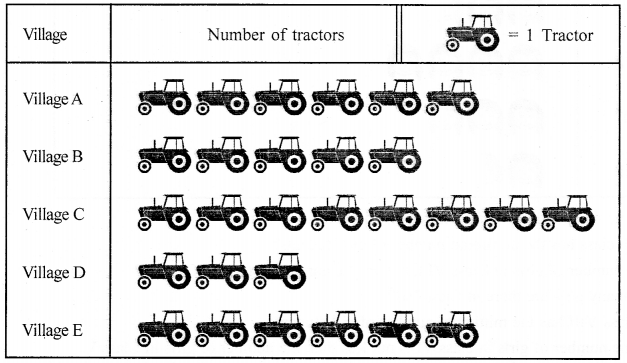
Observe the pictograph and answer the following questions.
(i) Which village has the minimum number of tractors?
(ii) Which village has the maximum number of tractors?
(iii) How many more tractors village C has as compared to village B.
(iv) What is the total number of tractor in all the five villages?
Solution:
(i) Village D has the minimum number of tractors.
(ii) Village C has the maximum number of tractors.
(iii) Village C has 8-5 = 3 more tractors as compared to village B.
(iv) Total number of tractors in all the five villages = 6 + 5 + 8 + 3 + 6 = 28.
Question 2.
The number of girl students in each class of a co-educational middle school is depicted by the pictograph.
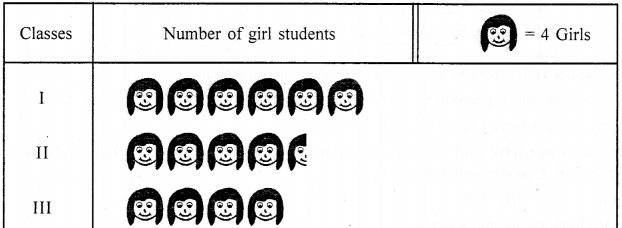
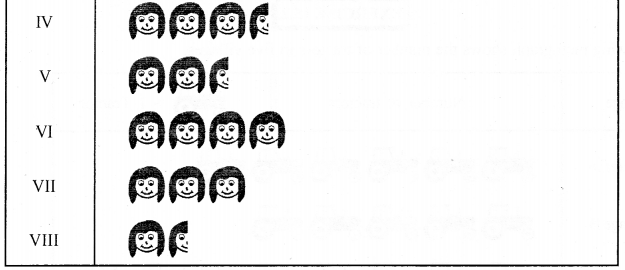
Observe this pictograph and answer the following questions :
(a) Which class has the minimum number of girl students?
(b) Is the number of girls in Class VI less than the number of girls in Class V?
(c) How many girls are there in Class VII?
Solution:
(a) Class VIII has a minimum number of girl students.
(b) No! the number of girls in class VI is not less than
the number of girls in Class V.
(c) Number of girls in Class VII = 3 × 4 = 12.
Question 3.
In a village, the following pictograph shows the number of fruit baskets sold by six merchants in a particular season:

Observe the above pictograph and answer the following questions:
(i) Which merchant sold the maximum number of baskets?
(ii) How many baskets were sold by Rajinder Singh?
(iii) The merchants who have sold 700 or more number of baskets are planning to buy a cold store for the next season. Can you name them?
Solution:
(i) Anwar
(ii) 750
(iii) Anwar, Rajinder Singh and Joseph.
Question 4.
In Gurgaon, the number of cars sold during a particular week was as follows:

Prepare a pictograph of the cars sold using a symbol of car ![]() representing 10 cars and answer the following questions:
representing 10 cars and answer the following questions:
(i) On which day the maximum number of cars were sold?
(ii) How many pictures of cars will represent the number of cars sold on Thursday?
Solution:

(i) Wednesday
(ii) 6
Question 5.
Total number of animals in five villages are as follows:

Prepare a pictograph of these animals using one symbol ® to represent 10 animals and answer the following questions:
(i) How many symbols represent animals of village E?
(ii) Which village has the maximum number of animals?
(iii) Which village has more animals: village A or village C?
Solution:
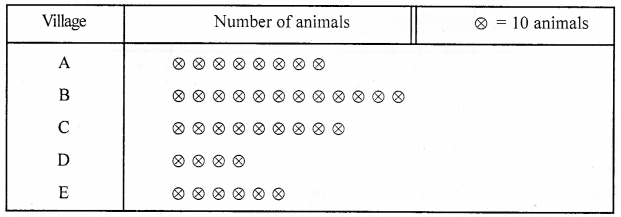
(i) 6
(ii) Village B
(iii) Village C
ML Aggarwal Class 6 Solutions for ICSE Maths Chapter 15 Data Handling Ex 15.3
Question 1.
Observe the adjoining bar graph showing the number of students in a particular class of a school.

Answer the following questions:
(i) What is the scale of this graph?
(ii) How many new students are added every year?
(iii) Is the number of students in the year 2015 is twice than that of in the year 2012?
Solution:
(i) 1 unit height = 10 students
(ii) 10
(iii) Yes
Question 2.
Observe the bar graph given below which is showing the sale of shirts in a readymade garment shop from Monday to Saturday.
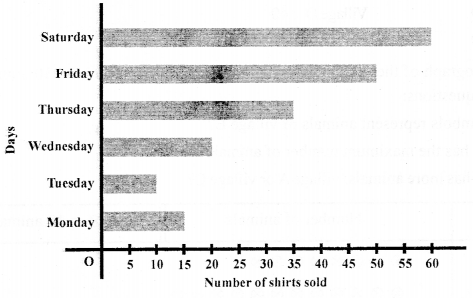
Answer the following questions:
(i) What information does the above bar graph give?
(ii) What is the scale chosen on the horizontal line representing number of shirts?
(iii) On which day were the maximum number of shirts sold? How many shirts were sold on that day?
(iv) n which day were the minimum number of shirts sold?
(v) How many shirts were sold on Thursday?
Solution:
(i) The bar graph shows the number of shirts
sold from Monday to Saturday,
(iii) 1 unit length = 5 shirts
(iii) Saturday; 60
(iv) Tuesday
(v) 35
Question 3.
Make a table corresponding to the following graph:
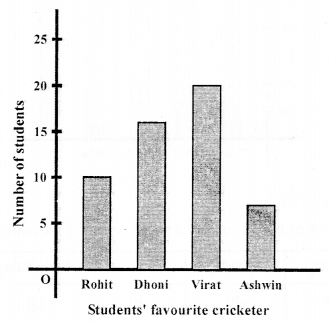
Solution:
Table showing student’s favourite cricketer:

Question 4.
The following table shows the number of bicycles manufactured in a factory during the years 2011 to 2015. Illustrate this data by using a bar graph. Choose a scale of your choice.

(i) In which year were the maximum number of bicycles manufactured?
(iii) In which year were the minimum number of bicycles manufactured?
Solution:
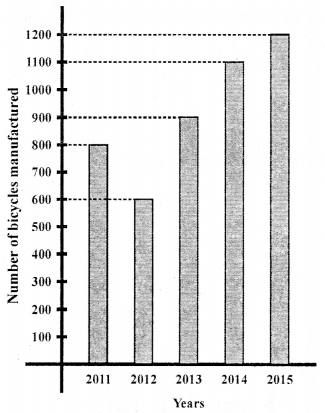
(i) 2015
(ii) 2012
Question 5.
The number of Mathematics books sold by a shopkeeper on six consecutive days is given below:

Draw a horizontal bar graph to represent the above information choosing the scale of your choice.
Solution:
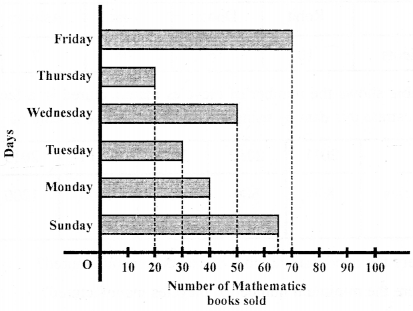
Question 6.
The number of persons in various age (in years) groups in a town is given in the following table:

Draw a bar graph to represent the above information and answer the following questions (take 1 unit height = 20,000 people):
(i) Which age groups have same population?
(ii) All persons in the age group of 60 and above are called senior citizens. How many senior citizens are there in the town?
Solution:

(i) 30 – 44 and 45 – 59
(ii) 1,20,000
ML Aggarwal Class 6 Solutions for ICSE Maths Chapter 15 Data Handling Ex 15.4
Question 1.
Find the mean of the following data :
(i) 40, 30, 30, 0, 26, 60
(ii) 3, 5, 7, 9, 11, 13, 15
Solution:
(i) Mean of 40, 30, 30, 0, 26, 60
No. of data (n) = 6
∴ Mean = \(\frac{40+30+30+0+26+60}{6}=\frac{186}{6}=31\)
(ii) Mean of 3, 5, 7, 9, 11, 13, 15
No. of data = 7
∴ Mean = \(\frac{3+5+7+9+11+13+15}{7}=\frac{63}{7}=9\)
Question 2.
Find the mean of the first five even whole numbers.
Solution:
First five even whole numbers are 0, 2, 4, 6, 8
Number of data = 5
∴ Mean = \(\frac{0+2+4+6+8}{5}=\frac{20}{5}=4\)
Question 3.
A batsman scored the following number of runs in six innings :
36, 35, 50, 46, 60, 55
Calculate the mean runs scored by him in an inning.
Solution:
In six innings, run scored was
36, 35, 50, 46, 60, 55
∴ Mean = \(\frac{36+35+50+46+60+55}{6}=\frac{282}{6}=47\)
Question 4.
The enrolment in a school for six consecutive years was as follows :
1555, 1670, 1750, 2013, 2540, 2825
Find the mean enrolment of the school for this period.
Solution:
Enrolment for 6 consecutive years is
1555, 1670, 1750, 2013, 2540, 2825
∴ Mean = \(\frac{1555+1670+1750+2013+2540+2825}{6}\)
= \(\frac{12353}{6}\) = 2058.83 = 2059
Question 5.
The marks (out of 100) obtained by a group of students in a science test are :
85, 76, 90, 85, 39, 48, 56, 95, 81, 75
Find the:
(i) highest and lowest marks obtained by the students.
(ii) mean marks obtained by the students.
Solution:
Marks obtained by a group of students in science test
85, 76, 90, 85, 39, 48, 56, 95, 81, 75
(i) Highest marks obtained = 95
Lowest marks = 39
(ii) Mean marks = \(\frac{85+76+90+85+39+48+56+95+81+75}{10}\) (Here n = 10)
= \(\frac{730}{10}\) = 73
ML Aggarwal Class 6 Solutions for ICSE Maths Chapter 15 Data Handling Ex 15.5
Question 1.
Find the median of the following data:
(i) 3, 1, 5, 6, 3, 4, 5
(ii) 3, 1, 5, 6, 3, 4, 5, 6
Solution:
(i) Arrange the data in ascending order
We get, 1, 3, 3, 4, 5, 5, 6
∴ Median = \(\left(\frac{n+1}{2}\right)^{t h}\) term
= \(\left(\frac{7+1}{2}\right)^{\text { th }}\) = 4th term
(ii) After arranging data, we get
1, 3, 3, 4, 5, 5, 6, 6
∴ Median = \(\frac{4+5}{2}=\frac{9}{2}=4 \cdot 5\)
Question 2.
Calculate the mean, the median and the mode of the numbers :
1, 3, 2, 6, 2, 3, 1, 3
Solution:
(a) Mean = \(\frac{1+3+2+6+2+3+1+3}{8}\)
= \(\frac{21}{8}\) = 2.625
Hence mean = 2.625
(b) Arranging the given data in ascending order, we get
1, 1, 2, 2, 3, 3, 3,6
Total number of observations (items) = 8 (even).
There are two middle items : – 2 and 3.
Their average = \(\frac{2+3}{2}=\frac{5}{2}=2 \cdot 5\)
Hence the median of the given numbers = 2.5.
(c) In the given numbers,
3 is repeated more number of time than any other number.
∴ Mode = 3.
Question 3.
Calculate the mean, the median and the mode of the following numbers :
3, 7, 2, 5, 3, 4, 1, 5, 3, 6
Solution:
(a) Mean = \(\frac{3+7+2+5+3+4+1+5+3+6}{10}=\frac{39}{10}=3 \cdot 9\)
Hence the mean = 3.9
(b) Arranging the given data in ascending order, we get,
1, 2, 3, 3, 3, 4, 5, 5, 6, 7
Total numbers of obvervations (items) = 10 (even)
There are two middle items – 3 and 4
Their average = \(\frac{3+4}{2}=\frac{7}{2}=3 \cdot 5\)
Hence the median of the given numbers = 3.5
(c) In the given numbers 3 is repeated more than any other number
∴ Mode = 3
